Casimir Davaine
| Casimir Davaine | |
|---|---|
|
Casimir Davaine | |
| Born | 19 March 1812 |
| Died | 14 October 1882 (aged 70) |
| Nationality | French |
| Fields | Microbiology |
| Known for | Bacillus anthracis |
Casimir Davaine (19 March 1812 – 14 October 1882) was a French physician known for his work in the field of microbiology. He was a native of Saint-Amand-les-Eaux, department of Nord.
In 1850, Davaine along with French pathologist Pierre François Olive Rayer, discovered a certain microorganism in the blood of diseased and dying sheep.[1][2] In the diseased blood, Rayer and Davaine observed the bacillus that is known today as Bacillus anthracis, the causative bacterium of anthrax. Soon afterwards, Rayer published a description of the bacillus in a paper titled, Inoculation du sang de rate (1850).[3][4]
In 1863 Davaine demonstrated that the bacillus could be directly transmitted from one animal to another. He was able to identify the causative organism, but was unaware of its true etiology.[5][6] Later on, German microbiologist Robert Koch inverstigated the etiology of Bacillus anthracis, and discovered its ability to produce "resting spores" that could stay alive in the soil for a long period of time to serve as a future source of infection.[7]
Casimir Davaine is also credited for pioneer work in the study of septicemia (blood poisoning).[8]
References
- Nancy Tomes The Gospel of Germs: Men, Women, and the Microbe in American Life
- Théodoridès, J (1994). "[Former observations of urinary bilharziasis and wuchereriosis]". Bulletin de la Société de pathologie exotique. 87 (3): 191–3. PMID 7827524.
- Rocchietta, S (January 1970). "[Casimir Joseph Davaine (1812-1882), pioneer of medical microbiology". Minerva Med. 61 (6): XI. PMID 4904892.
- Théodoridès, J (April 1966). "Casimir Davaine (1812-1882): a precursor of Pasteur". Medical History. 10 (2): 155–65. doi:10.1017/S0025727300010942. PMC 1033586
 . PMID 5325873.
. PMID 5325873. - LAGRANGE, E (February 1955). "[Casimir Davaine, pioneer in two fields.]". La Presse médicale. 63 (12): 234–5. PMID 14371473.
- ↑ Pierre François, Olive Rayer (1850). "Inoculation du sang de rate". Comptes Rendus des Séances et Mémoires de la Société de Biologie. 2: 141–144.
- ↑ Anthrax: A History, by Richard M. Swiderski In 1849 German physician Aloys Pollender (1799–1879) noticed the organism in the blood of five dead cows, however, he didn't publish an account of his findings until 1855.
- ↑ Heinrich Hermann Robert Koch - bibliography Who Named It
- ↑ Biography of Pierre-François-Olive Rayer at Who Named It
- ↑ Biographical Encyclopedia of Scientists, Third Edition edited by John Daintith
- ↑ Vaccination: A History by H. Bazin
- ↑ Tapeworms, Lice, and Prions: A compendium of unpleasant infections by David Grove
- ↑ Micro-organisms and Disease: An Introduction Into the Study of Specific ... by Edward Klein
